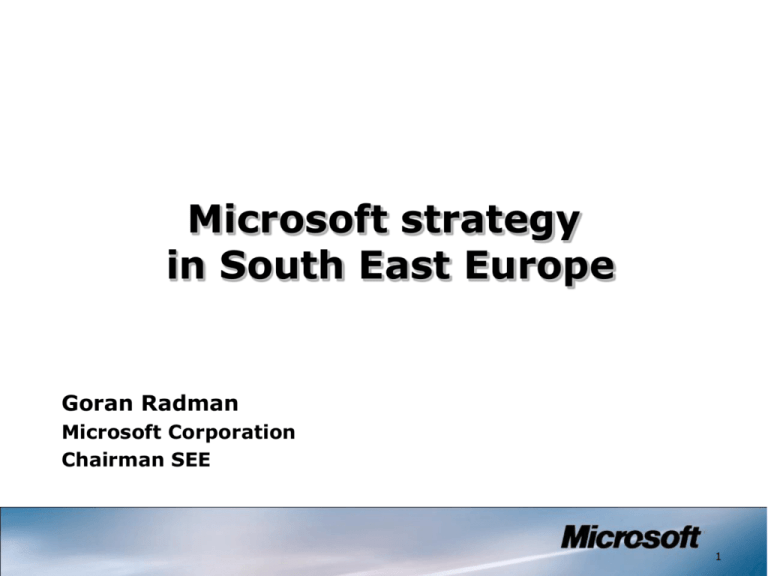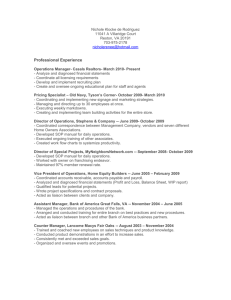
Microsoft strategy
in South East Europe
Goran Radman
Microsoft Corporation
Chairman SEE
1
SEE Region
9 countries
1.
2.
3.
4.
5.
6.
7.
8.
9.
Albania
Bosnia & Herzegovina
Bulgaria
Croatia
Macedonia
Moldova
Romania
Serbia & Montenegro
(incl. Kosovo)
Slovenia
6 Microsoft Subs
–
–
–
–
–
–
Ljubljana (SLO) – 1995
Bucharest (ROM) – 1996
Zagreb (CRO) – 1997
Sofia (BUL) - 1999
Beograd (SMN) – 2002
Skopje (MKD) - 2004
2
Microsoft in SEE
Microsoft South East
Europe region
262 FTE employees
Staff by country (FTE;vendors/others):
Staff by function:
Albania: /
SEE and Local Management: 8 (8;0)
Moldova: /
Bosnia & Herzegovina: / Romania: 64 (52;12)
Sales & Marketing: 140 (84;56)
Bulgaria: 30 (20;10)
Serbia & Montenegro: 35 (14;21)
Services: 66 (53;13)
Croatia: 63 (37;26)
Slovenia: 64 (39;25)
F&A: 32 (10;22)
Macedonia: 6 (4;2)
SEE Team: 16 (11;5)
3
ICT Market Indicators
Key market
indicators
PC installed
base
(FY05)(1)
PC
shipment
(FY05)(1)
IT spend in
US$mio
(CY04)(2)
Piracy rate
(CY04)(3)
22.228
6.064
n/a
n/a
Bosnia & Herzegovina
130.317
34.913
n/a
90%(1)
Bulgaria
490.000
90.000
307
71%
Croatia
716.531
148.066
601
58%
Macedonia
121.507
23.952
n/a
80%(1)
Moldova
n/a
n/a
n/a
n/a
Romania
1.385.925
351.749
816
74%
Serbia & Montenegro
701.622
114.159
381
70%(1)
Slovenia
653.712
112.004
561
51%
Albania
Source: (1)Microsoft estimates; (2)IDC, 2005; (3)BSA/IDC, 2005
4
SEE Region in Context, 2004
30.000
25.000
20.000
15.000
10.000
5.000
0
Italy
Spain
Belgium
Austria
CEE
SEE
Ireland
Portugal
Russia
SEE Region is of the Same Size as the Portuguese Market
Source: IDC WW Black Book, April 2005
5
South East Europe’s IT Industry
IT as a % of GDP
2000
1.1%
2001
1.2%
2002
1.3%
2003
1.4%
2004
1.5%
2005
1.7%
2006
1.7%
2007
1.8%
2008
1.9%
YE 2000-2008
$4,000
$3,500
$3,000
$2,500
$2,000
$1,500
$1,000
$500
$Total IT Spending ($B)
Source: IDC IT Economic Impact Study, 2005
IT Tax Revenues (US$B)
6
Enduring Low-end Technology
• Strong Focus on Low-end
Hardware
• PCs and Related
Technologies Still with
Major Share
• Hardware Investments
Will Remain Strong
Reflecting Infrastructure
Development and State of
Smaller Country Markets
• Software & Services
Categories Illustrates
Highest Growth
Drive Exceptional Spending
Servers
8%
Networking
Equipment
7%
Peripherals
13%
IT Services
22%
Packaged
Software
15%
PCs & TWS
32%
Storage
3%
SEE Total = $2.7 billion
Source: IDC WW Black Book, April 2005
Executive Summary
• Growth in the IT sector is dynamic and will continue on
an upward trajectory through 2008
• The software market will grow at 13% average
compound growth rate between now and 2009
• In the next five years, the IT sector will generate over
35,000 new jobs; tax revenues will be $500 million
higher in 2009 than 2004
• Approximately 47% of all SEE IT employees are engaged
in creating, distributing, or servicing software – for
external customers or internal corporate users – and
just under 55% of all IT tax revenues come from the
software-related sector.
• Over half of 2004 employment and tax revenues
stemmed from the vast Microsoft ecosystem.
• For every dollar of Microsoft revenue in the region
another $8.65 were generated by other companies
selling hardware or software that works on Microsoft
operating systems or servicing that software.
Source: IDC IT Economic Impact Study, 2005
8
Microsoft’s Global Citizenship Initiative is focused
on mobilizing our resources across the company and
around the world, to create opportunities in the
communities where we do business, and to fulfill our
commitment to serving the public good through
innovative technologies and partnerships
•Corporate Governance
•Competition and
Compliance
•Contracts, Indemnification
and Product Liability
•Diversity
•Environment
•Interoperability
•Intellectual Property
.
•Child Safety
•Content Regulation
(including games)
•Computer Crimes (including
hacking and viruses)
•ID Theft and Phishing
•Privacy
•Spam
•Spyware/Adware
• Value of Proprietary
Software
• Local Software Economy
• Innovation
• Jobs and Skills (Digital
Inclusion)
• Economic Growth and
Development
9
Multi-stakeholder Partnerships
for SEE
Government
Academia
Private
Sector
International
Community
10
e-Government
SEE E-GOVERNANCE CENTER
e-Government policy and institutional capacity
building support through shared expertise, best
practices and standards in public services
Support for multilateral exchange of IT skills,
competencies and solutions
for public administration
Replicate Tallin (Estonia)
EGC to Bled (Slovenia)
11
e-Business
IT entrepreneurship and innovative SMEs
support through local incubators
Incubator as source of new IT ideas,
business solutions knowledge base and best
practice share-point
BTC Varaždin (Croatia) as
a model for the SEE region
12
Local Software Economy
What is the Local Software Economy (LSE) Initiative?
The LSE initiative is designed to help a subsidiary engage with local
policymakers, industry leaders and influential's on the topic of building
the local software economy. The effort helps field teams shape activities
to support the local software economy, how a robust local software
economy can create opportunities in the broader economy, and how to
message and appropriate position MS activities.
What’s the focus of the LSE effort?
The effort is focused on building strong local software economies, and
helping governments, policymakers and influential's understand how to
do so. Microsoft’s commitment to LSE does not promise economic
growth or development, but does explain how MS contributes to and
supports a robust local software economy.
13
Business Technology Centres
What: Technology centers offering a comprehensive set of
programs and services to foster innovation and grow
sustainable local software economies.
Why: To connect people and organizations in the innovation
ecosystem and give them access to resources, experts and
facilities for collaboration and skills development.
Who: Students, entrepreneurs, academics, professional
software developers, startups, IT professionals, industry
organizations and local governments.
How: Sixty centers today; 90 centers in 30 nations by the end
of 2006.
Outcome: Local centers around the world foster skills and
intellectual capital, industry partnerships and innovation.
14
Microsoft Business Technology Center Varaždin, Croatia
•
•
•
Objective:
Microsoft Business-technology Centre has the task
to provide the infrastructure and resources to help
ISVs create innovative new products and services,
bring those products and services to market, and
build well-managed competitive businesses around
those innovative products and services.
Functions:
1. Learning Centre
–
1/3 Technology (above CTEC’s)
–
1/3 Operations
–
1/3 Business (Sales, MKTG, Export,
Outsourcing, EU Funds,...)
2. Testing new applications on “state-of-the-art”
hardware
3. “Show Room” for partners and customers
USAID – Microsoft joint venture project
15
MIC Bucharest
•
•
•
•
•
•
Activity Description
– Microsoft Innovation Centre
Activity Goal/Objective
– Innovation Centre where IT&C companies could come to learn about e-gov
solutions and to test their own solutions
Success Metrics
– In Q3 FY07 MIC should deliver the first training classes, which address Microsoft
technologies and e-gov solution and at the end of FY07 at least 5 ISV has to be
involved in developing solutions on top of E-gov
Deliverables/Milestones
– Q1 – Partnership with a hardware provider to establish MIC infrastructure
– Q2 – MIC Personnel to be trained on Microsoft and e-gov solution
– Q3 – Launch of MIC, first PR events, and delivery of first training
– Q4 – consolidate ISV community around MIC
Stakeholders
– Zsolt Nagy – Minister
– Catalin Marinescu – President IGCTI
– Ovidiu Artopolescu – GM MS Romania
Post-FY07 Funding:
– This MIC would be self sustainable in FY08.
16
16
© 2004 Microsoft Corporation. All rights reserved.
This presentation is for informational purposes only. Microsoft makes no warranties, express or implied, in this summary.








